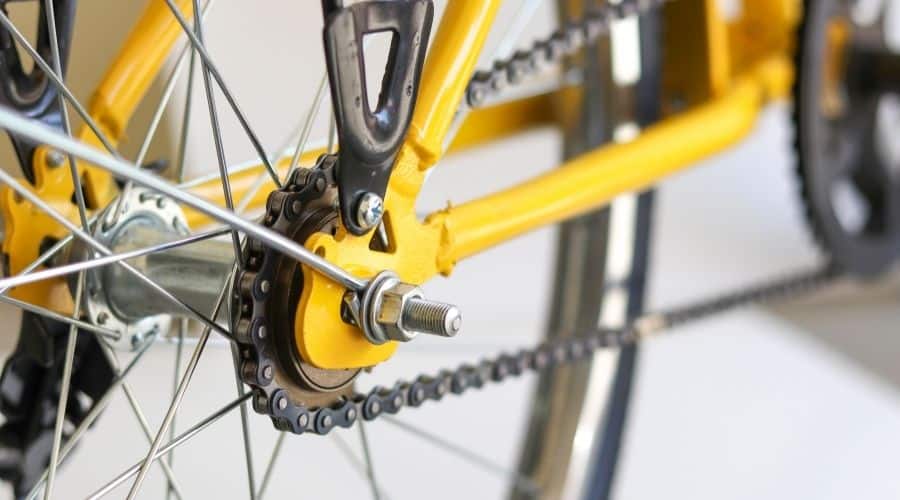It’s a common misconception that a bike chain has to be tight in order to work correctly, but that’s not the case. There should be some play so that the chain can shift gears up and down to sprockets of different sizes. Sadly, too much slack is a problem. Why does my bicycle chain slip?
The most common reason a bicycle chain slips is that the fit is loose due to a very stretched chain or worn cogs teeth. A bike chain needs a little leeway so you can shift up and down gears, but too much slack, and it will slip.
Recommended Gear
To see all of my up-to-date recommendations for bikes and cycling gear, check out this resource that I made for you!
Table of Contents
Why Does My Chain Slip On My Bike
When a chain slips, it is not catching the way it should on the teeth of your cassette sprockets.
This can result from debris in the chain preventing it from connecting correctly or too much wear on the parts. Worn gear teeth don’t stick up far enough.
Meanwhile, a worn chain has what is known as cable stretch, a phenomenon that causes it to fit more loosely as it wears out.
New Bike Chain Slipping When Pedaling Hard
It can be highly frustrating when your brand new chain starts slipping when you’re pedaling hard.
Always double-check for the correct size before installing a new chain. It’s a simple mistake, but anyone can accidentally grab the wrong one.
Once you’re sure you have the correct chain, the next most likely culprit is your shift cable.
You should be able to correct the problem by tightening this part so there’s less slack, which will get you a better, smoother shift and little to no slippage.
Bike Chain Slipping On Front Sprocket
It is almost always from cable stretch when your bike chain slips on the front sprocket.
You’ve had the same bike chain for too long without replacing it, and though it seems like a sudden new problem, the chain has actually been stretching slowly the entire time you’ve used it.
There’s nothing out of the ordinary here, and the fix is simple. It’s time for a new chain.
New Bike Chain Slipping Under Load
You’ve changed out your bike chain, and the cassette is in good condition, but now your new bike chain is slipping under load. What can you do?
Luckily there’s an easy solution here too. You need to check your cables.
The first few times you ride, or the first long ride you take, will often cause those cables to stretch.
This isn’t the same as wearing them out, and it’s perfectly normal. You need to go in and tighten them back up, which should solve the problem.
Is it still not working right? Doublecheck your front derailleur position. It won’t put the necessary tension on your bike chain when this is improperly aligned.
If that doesn’t work, you should check the rear derailleur next. It’s not difficult to bend a derailleur if you ride hard, lay a bike on its side, or simply knock it over by accident.
Bike Chain Slipping In One Gear
If your bike chain slips, but it only ever happens in the same gear, there are three probable culprits.
Rust, dirt, and uneven wear are what cause single-gear chain slippage. The good news is that if it’s dirt, you can fix it with a simple cleaning.
Regrettably, when the problem is rust or uneven wear, you need to replace the gear.
This can mean replacing the entire cassette, which can cost anywhere from twenty dollars to over a hundred and fifty. However, if you have a Shimano, there’s good news.
According to Bicycles Stack Exchange, “…you can change an individual sprocket in a cassette, at least for Shimano… the adjacent gears have to be carefully matched to each other. So, if you change a sprocket for another sprocket with a different number of teeth, then shifts to and from that sprocket won’t be as smooth.”
New Chain Slipping On Cassette
Usually, when you put a chain on your cassette, the two wear at a similar rate. Some gears wear out faster as you favor them or need them more on your local terrain, but wear will still occur.
Good lubricant and regular cleaning go a long way toward extending the life of the sprockets and chain.
Still, eventually, over time, they will grind each other down, but what does that have to do with why your new chain is slipping on the cassette?
A new chain hasn’t worn down at all. The problem here is most likely your cassette. It’s always good to replace worn cassette parts and chains simultaneously, even if one has more apparent wear than the other.
Doing this will prevent your new chain from slipping on old, worn-down gears.
How To Fix A Slipped Bike Chain
Fixing a slipped bike chain is typically incredibly simple. However, it is also often messy, thanks to the lubricating grease, so you may want a set of gloves for this fix.
Below I’ve outlined two simple ways to fix your slipped bike chain, but if these don’t work out or the problem persists, you may need to shorten your chain or replace it with a new, unworn version.
- Downshift to your lowest gear first.
- Try pedaling and see if this realigns the chain, as it will often help self-correct as your chain moves along the largest gear and becomes tauter.
- If the first two steps don’t work, you should move your front derailleur forward and manually reset the chain. You may want to work on a bike stand or turn your bike upside down to rest on its handlebars and seat, but it’s also possible to make this fix in an upright position.
- Finally, move the pedals or wheels forward, so the chain realigns properly.
If you need a visual to help you with this process, I recommend this video from Helpful DIY. In it, they show a quick, easy way to put your chain back where it belongs so you can ride home safely.
Helpful Tips To Know About Why Bicycle Chains Slip
Cable stretch and cassette wear are the most common reasons any bike chain slips. Unfortunately, by the time you notice slippage, it often means you need to replace both parts.
Here are more helpful tips to know about why bicycle chains slip.
- You should clean and re-lubricate your chain at least once every two thousand miles or once a month. However, if you live in an area with lots of sand, ride dirt trails, or have a lot of debris around, you may need to clean it more often. Preventing particulate matter, small rocks, and other ‘dirt’ from blocking up links on your bike chain can help prevent slippage.
- Be careful when purchasing your bicycle chain. Most riders know that you need the right size chain, but you may not know that some chains are one-directional. If you put a one-way chain backward, it may slip off.
- Is your chain coming off the outside of the chainset regularly? If this is the only place it is slipping, you may have your H screw set wrong. You need to turn it an eighth of the way forward or back to get the proper tension.
Final Thoughts
When you ride a bicycle, you will eventually experience a chain slip. Mostly it is a natural result of wear over time caused by metal parts rubbing against one another.
The cassettes’ teeth get smaller over time as the chain rubs minute bits of metal off them, and the chain separates and also loses tiny bits of metal causing cable stretch.
There are other possible causes, including too-large chains, dirt, rust, and improperly set screws, but ninety percent of the time, it’s an indication that you need a new chain and cassette.

